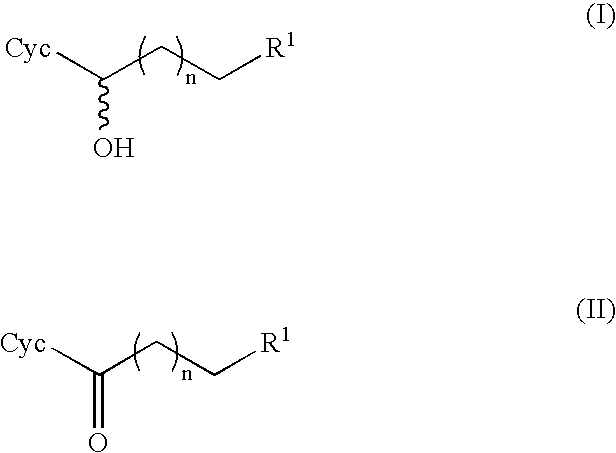Method For Producing Optically Active Alcohols From Alkanones Using a Dehydrogenase of Azoarcus
a technology of azoarcus and alkanone, which is applied in the field of producing optically active alcohols from alkanones using a dehydrogenase of azoarcus, can solve the problem of stable sensitivity of the lah-icb reduction system
- Summary
- Abstract
- Description
- Claims
- Application Information
AI Technical Summary
Benefits of technology
Problems solved by technology
Method used
Image
Examples
example 1
Cloning of the Azoarcus sp EbN1 Phenylethanol Dehydrogenase by Means of Synthetic Oligonucleotides
[0150]The sequence of the gene of Azoarcus sp EbN1 phenylethanol dehydrogenase has been deposited in databases (Genbank ID 25956124, region: 25073 to 25822). Oligonucleotides from which the gene was synthesized according to known methods were derived from the nucleic acid sequence of the phenylethanol dehydrogenase gene. Table 1 summarizes the DNA sequence of said oligonucleotides. FIG. 3 indicates the position of the individual oligonucleotides in relation to the entire Azoarcus sp EbN1 phenylethanol dehydrogenase gene. Methods of preparing synthetic genes have been described, for example, in Y. P. Shi, P. Das, B. Holloway, V. Udhayakumar, J. E. Tongren, F. Candal, S. Biswas, R. Ahmad, S. E. Hasnain and A. A. Lal, Vaccine 2000, 18, pp. 2902-2914. The sequence obtained is identical to the published sequence.
[0151]The PCR product was digested with the restriction endonucleases NdeI and B...
example 2
Cloning of Azoarcus sp EbN1 Phenylethanol Dehydrogenase by Means of PCR
[0152]The sequence of the gene of Azoarcus sp EbN1 phenylethanol dehydrogenase has been deposited in databases (Genbank ID 25956124, region 25073 to 25822). Oligonucleotides (primers MKe0387 and MKe0388) were derived from the nucleic acid sequence of the phenylethanol dehydrogenase gene, which were used for cloning the dehydrogenase gene by means of PCR amplification as follows.
PCR:TemplatePrimerProduct lengthSubcloned DNA from Azoarcus sp EbN1MKe0387approx. 750 bpor chromosomal DNA from Azoarcus spandEbN1MKe0388
Primers:PrimerNo.Sequence (5′->3′)PositionMKe0387GGGAATTCCATATGACGCAAAGACTGAAGGN-terminalprimerMke0388CGCGGATCCTCAGTGTCTCACCATACCGCCC-terminalprimer
[0153]Equimolar amounts (130 ng each) of primers MKe0387 and MKe0388 were mixed. The PCR was carried out according to the standard Stratagene protocol using PfuTurbo polymerase (Roche Applied Science) and the following temperature gradient program: 95° C. for ...
example 3
Provision of Recombinant Phenylethanol Dehydrogenase of E. coli LU 11558
[0155]E. coli LU 11558 were grown in 20 ml of LB-Amp / Spec / Cm (100 μg / l ampicillin; 100 μg / l spectinomycin; 20 μg / l chloramphenicol), 0.1 mM IPTG, 0.5 g / l Rhaminose in 100 ml. Erlenmeyer flasks (baffles) at 37° C. for 18 h, centrifuged at 5000*g for 10 min, washed once with 10 mM TRIS.HCl, pH7.0 and resuspended in 2 ml of the same buffer. Cell-free protein crude extract was prepared by disrupting E. coli LU 11558 cell paste with 0.7 ml of glass beads (d=0.5 mm) in a vibratory mill (3×5 min with intermediate cooling on ice).
PUM
| Property | Measurement | Unit |
|---|---|---|
| temperature | aaaaa | aaaaa |
| temperature | aaaaa | aaaaa |
| pressure | aaaaa | aaaaa |
Abstract
Description
Claims
Application Information
 Login to View More
Login to View More - R&D
- Intellectual Property
- Life Sciences
- Materials
- Tech Scout
- Unparalleled Data Quality
- Higher Quality Content
- 60% Fewer Hallucinations
Browse by: Latest US Patents, China's latest patents, Technical Efficacy Thesaurus, Application Domain, Technology Topic, Popular Technical Reports.
© 2025 PatSnap. All rights reserved.Legal|Privacy policy|Modern Slavery Act Transparency Statement|Sitemap|About US| Contact US: help@patsnap.com



